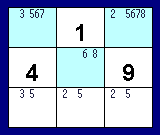Hidden Subset
This is where the same two possibilities exist only in two squares within the same block, row or column. This also works where three possibilities exist in no more than three squares or where four possibilities exist in no more than four squares. Consider the following block:

The highlighted squares are the only three squares in this block that contain 6, 7 and 8 as possibilities. We can deduce that these two squares must contain a 6, 7 and 8 (although we don't know which square contains which number). Therefore we can remove the other possibilities from these squares (i.e. the 3 and 5 from the top left-hand square and the 2 and 5 in the top right-hand square). Doing this leaves a hidden single of 3 in the bottom left-hand square, which means this square must be a 3.
| << Prev | Strategies | Next >> |